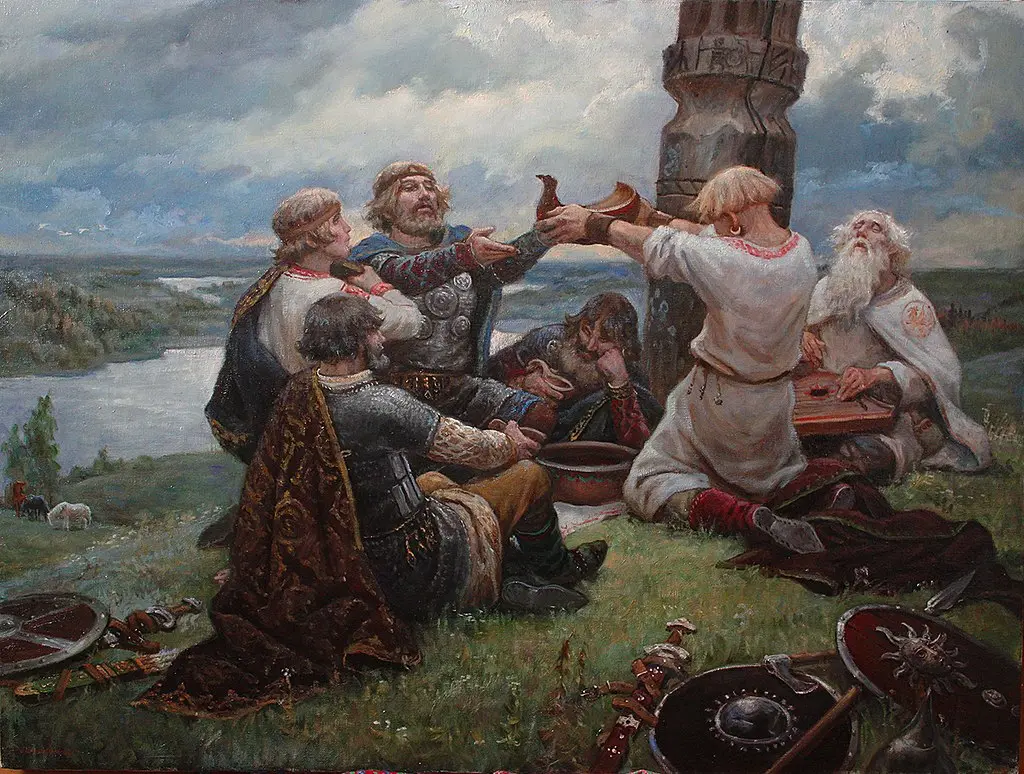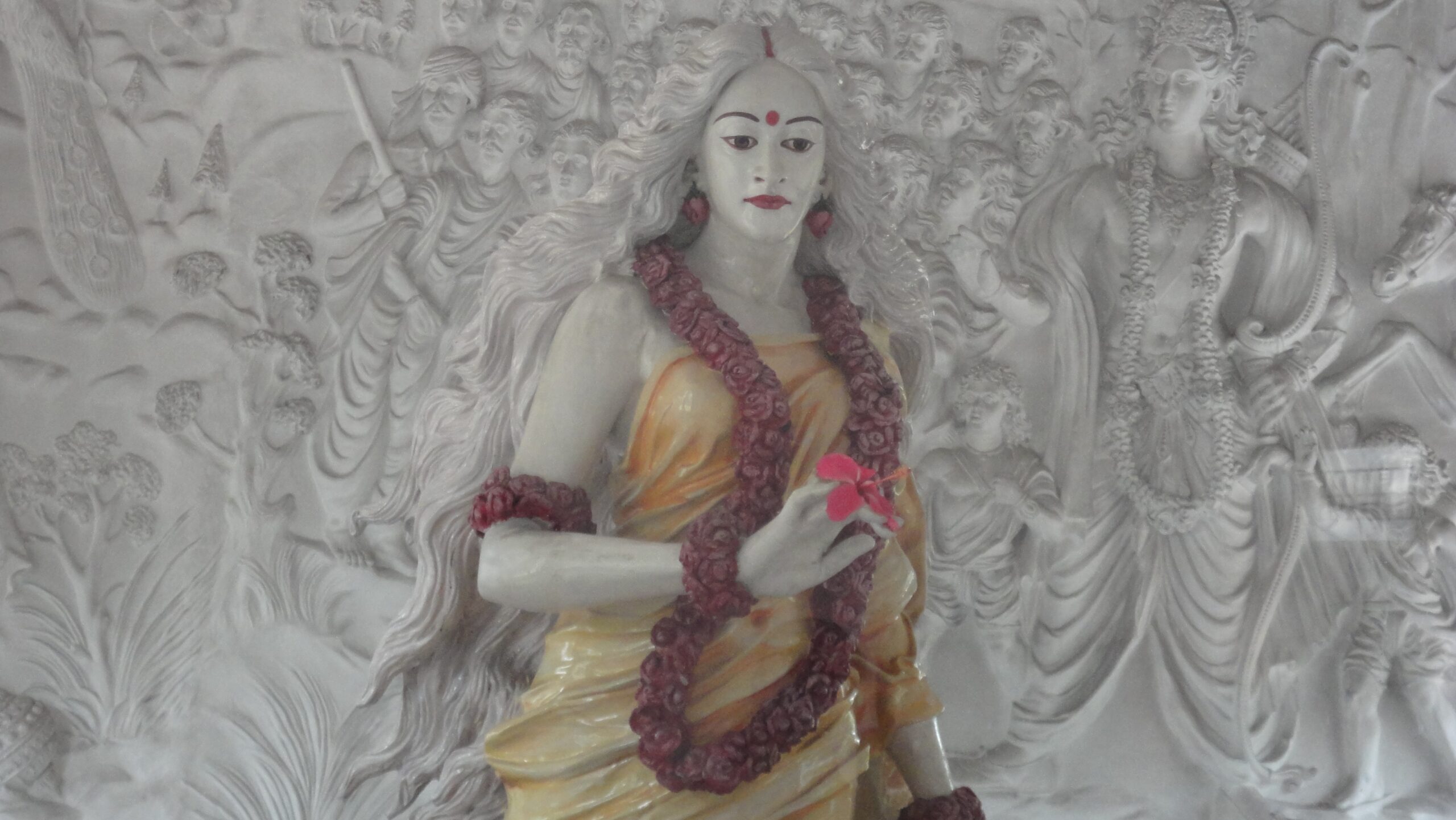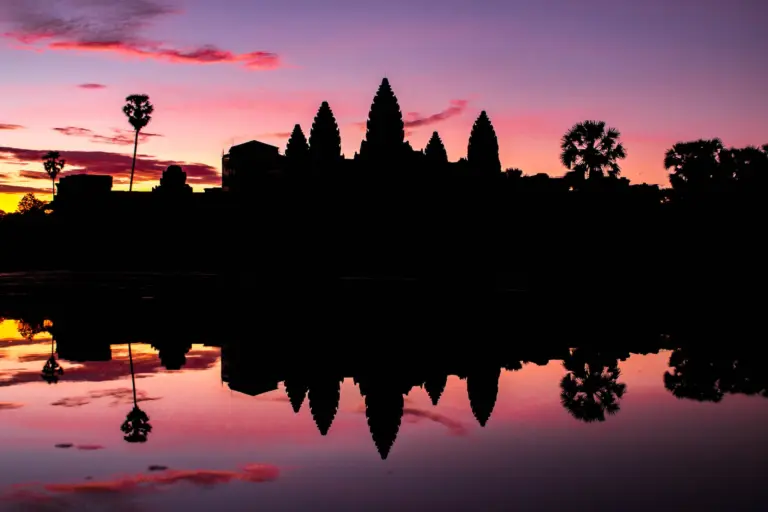The Tarot.
A deck of cards steeped in mystery that serves not only as a tool for divination but also as a powerful medium for meditation and reflection.
Each card in the Tarot deck is a mirror reflecting the complex facets of the human experience, capturing the essence of our deepest spiritual quests, psychological landscapes, and the universal archetypes that dance through our lives.
The symbols adorning each card speak in the language of the subconscious, tapping into the wellspring of our collective unconscious. Through a blend of imagery, colors, numbers, and icons, the Tarot cards weave a story that transcends the boundaries of time and culture, offering guidance, wisdom, and insight.
In exploring Tarot symbolism, we embark on a journey not only through the external world of universal themes but also inward, to the very core of our being. For it is here, in the silent dialogue between the symbols on the cards and the hidden rooms of our psyche, that the true magic of the Tarot unfolds.
Table of Contents
Toggle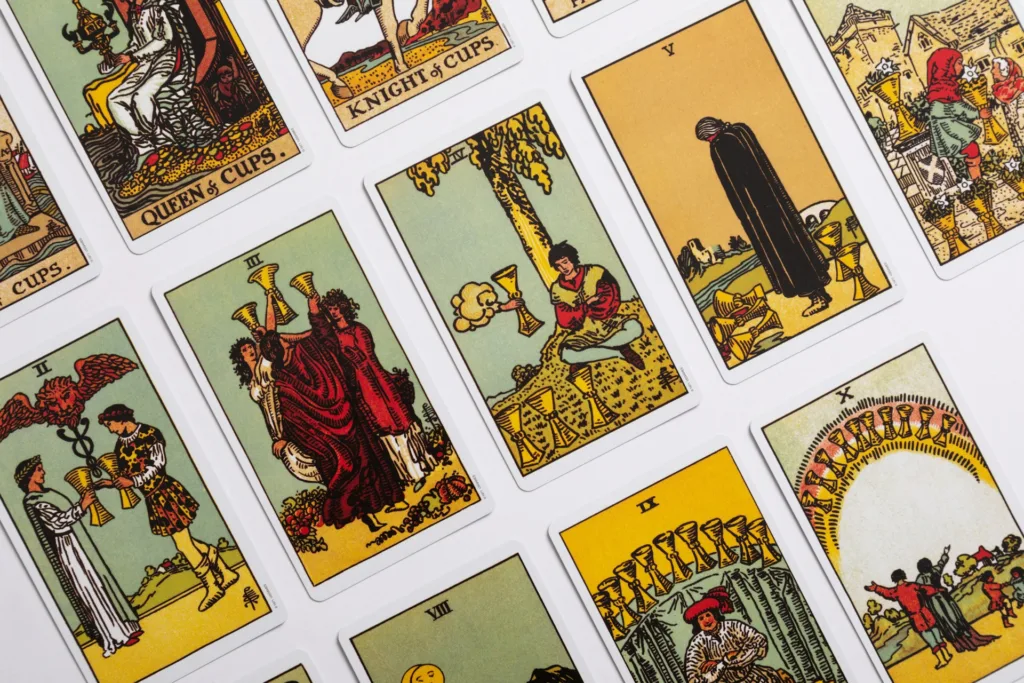
Understanding Tarot Symbolism
Symbolism is the soul of the Tarot, a visual shorthand that conveys complex spiritual, psychological, and archetypal concepts intuitively. This symbolism isn’t arbitrary but rather carefully crafted, with each aspect of a card’s design serving to convey layers of meaning, here’s how:
- Imagery: Each image serves as a conduit for storytelling, archetypal representation, and the invocation of emotion and thought.
- Colors: Colors in Tarot cards are chosen with purpose, each hue imbuing the card with specific energies, emotions, and spiritual meanings. Red, for instance, often symbolizes passion, action, and courage, while blue can denote intuition, calm, and spirituality.
- Numerology: Each card’s number offers insight into its core essence and place within the deck’s structure. Understanding the vibrational essence of numbers helps to decipher the deeper messages and lessons the Tarot imparts.
- Symbols: Tarot cards are also replete with a variety of symbols, each adding to the narrative and significance of the readings. These can include natural elements (like water, indicating emotion and intuition), animals (eagles for spiritual clarity, lions for strength), or objects (swords for conflict or thought, cups for emotions). These symbols draw from a well of common human experience and spiritual tradition, making the Tarot a universal tool for insight.
- Astrology: Many Tarot cards are associated with specific astrological signs, linking the cards to larger cosmic forces and energies.
- Elements: The elemental associations—fire, water, air, and earth—help categorize the cards according to the aspects of human experience they represent, such as action, emotion, thought, and materiality, respectively.
In understanding these foundational elements of Tarot symbolism, we gain the ability to conduct readings with a more profound appreciation of the deck’s intricate language. This knowledge not only enhances the interpretive depth of Tarot readings but also deepens our connection to the universal stories and truths the Tarot reflects, guiding us toward greater self-awareness and understanding.
Symbolism of the Major Arcana
At the heart of the Tarot deck lies the Major Arcana, a series of 22 cards that form the cornerstone of Tarot’s wisdom. These cards are the archetypal stepping stones of the human experience, guiding us through the myriad stages of life’s journey. From the innocence and potential of The Fool to the completion and unity of The World, the Major Arcana encapsulates the essence of our spiritual quests, personal developments, and the universal cycles of growth and change we all face.
For the sake of this article, given the influential legacy of the Rider-Waite-Smith (RWS) Tarot system, its imagery will serves as a standard reference point for discussing the symbols, colors, and thematic elements. (As there are quite a lot of decks out there.)
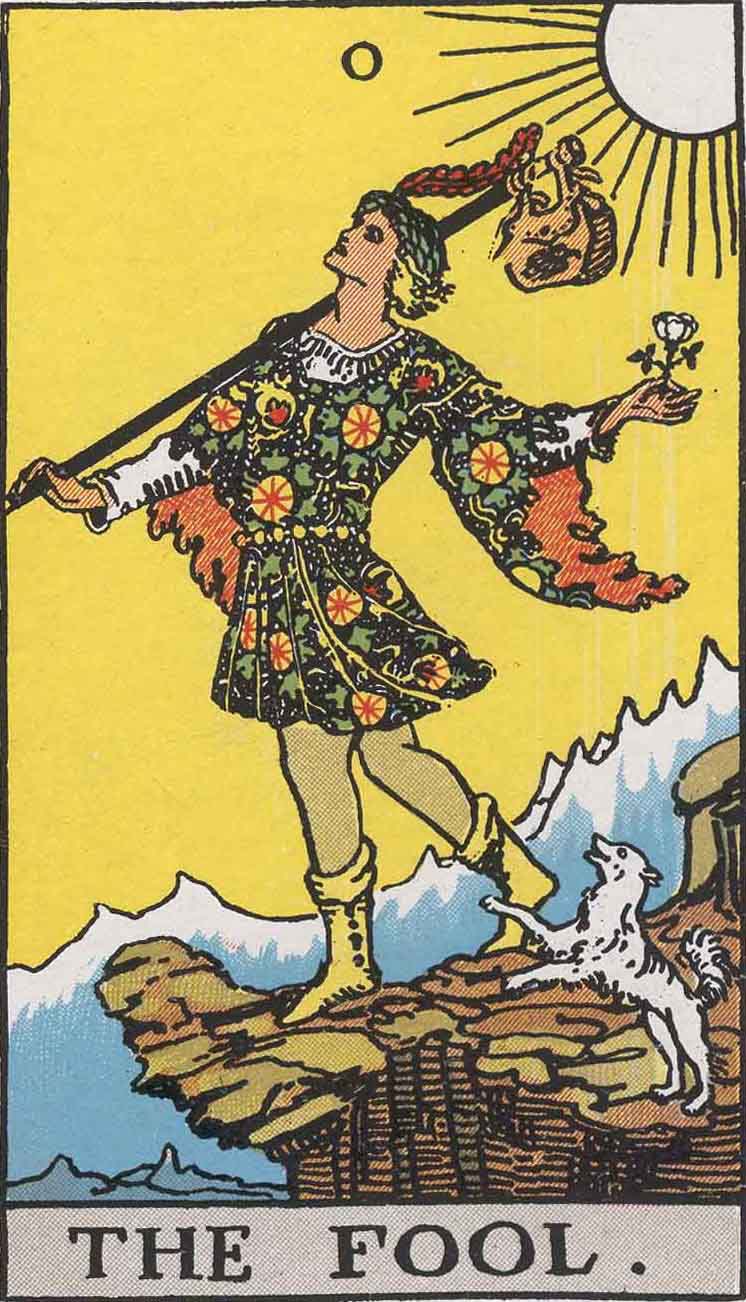
The Fool reminds us that every journey begins with a single step, and that step is an act of faith and a declaration of trust in life’s grand adventure.
0 - The Fool
The Fool stands as the inaugural card of the Major Arcana, embodying the very essence of beginnings, potential, and the joyful leap into the unknown. Marked by the numeral 0, it holds a place both at the start and outside the traditional sequence of the Tarot, symbolizing infinite possibilities and the cyclic nature of journeys and life itself.
This card’s imagery is rich with symbols of carefree abandon and trust in the universe; the Fool is depicted on the brink of a cliff, stepping forward into the void, often with a small dog at his heels. The sun shining brightly signifies optimism and the sack on the Fool’s shoulder illustrates carrying past experiences into the new journey.
The number 0 represents potential and the unformed; it is the void from which all things begin and to which they return, encapsulating the Fool’s theme of endless possibilities and new beginnings. This card invites us to embrace our own journey with open-hearted courage and to trust in the path that unfolds before us, even when it leads into the unknown.
The Fool is associated with air, highlighting the importance of intellectual freedom, flexibility, and the courage to move into new territories. The Fool also embodies the qualities of Uranus, the planet of revolution, sudden changes, and breaking free from constraints, emphasizing the theme of stepping into a new phase of life with an open spirit.
The Fool often resonates with the archetype of the wanderer and trickster; figures who, through their journeys, teach us the value of embracing life’s unpredictability and the wisdom found in innocence and folly.
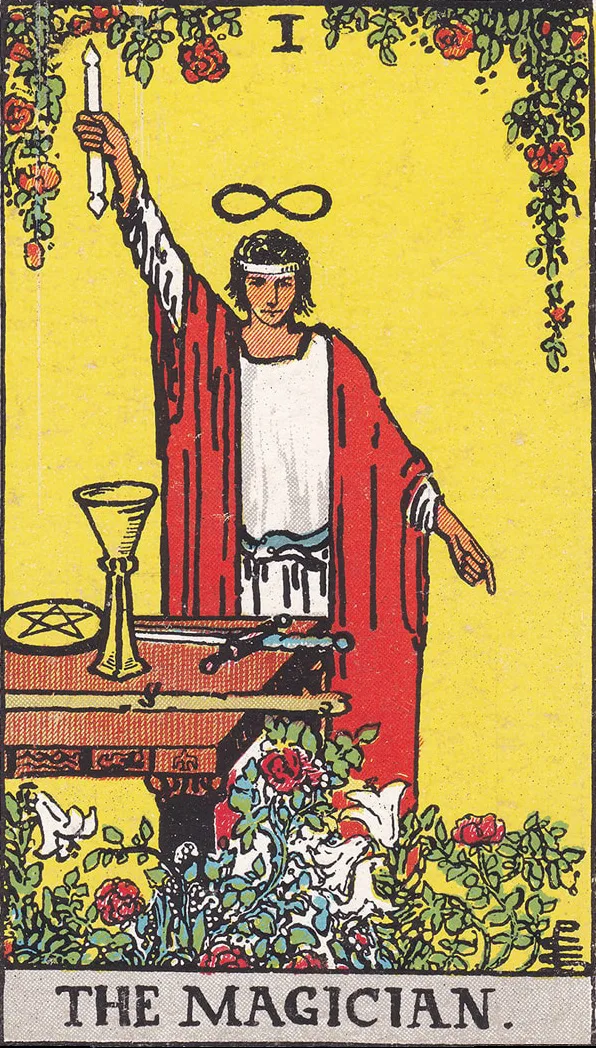
Through the Magician, we learn that true magic lies in our ability to focus our will, harness our resources, and take decisive action to bring about the reality we desire.
I - The Magician
The Magician card, standing as the first numbered card in the Major Arcana, is a powerful symbol of manifestation, resourcefulness, and the transformative power of will.
The Magician is depicted as a figure standing before a table on which are laid out the four suits of the Tarot—cups, pentacles, swords, and wands—each representing the elements of water, earth, air, and fire. This imagery signifies the Magician’s ability to harness the diverse energies of the universe to manifest his desires.
Above his head is the symbol of infinity, indicating endless possibility and the eternal cycle of creation and destruction, reflecting his mastery over the physical and spiritual realms.
The number 1 is a number of beginnings, leadership, and initiative. It signifies the potential for new ventures and the power of the individual to shape their reality. The Magician teaches that with clear intention, mastery of one’s skills, and the willingness to act, anything is possible.
The Magician also has associations with the planet Mercury or Hermes, the messenger of the gods, known for the ability to traverse between worlds. This astrological correspondence underscores the Magician’s role as a conduit between the divine and the mundane, channeling cosmic energies into the material world.
The Magician reminds us that we are not passive observers of our fate but active participants in shaping our destiny, equipped with all the tools necessary to realize our highest potential.
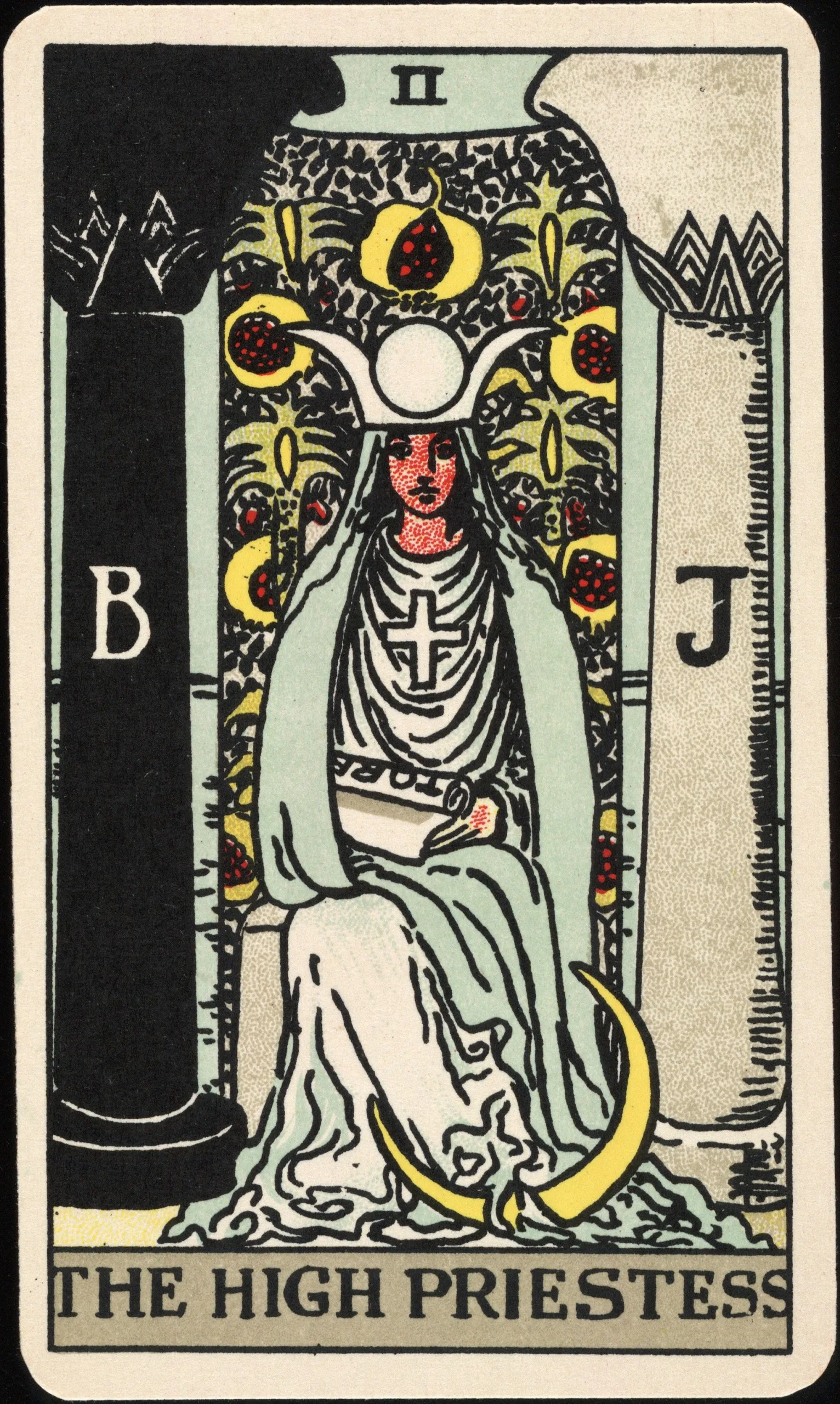
The High Priestess serves as a guide on our journey inward, illuminating the path to self-awareness and the mysteries that lie at the core of our existence.
II - The High Priestess
The High Priestess, seated on her throne between the pillars of Boaz and Jachin (which stood on the porch of Solomon’s Temple, the first Temple in Jerusalem), embodies the mysteries of the subconscious, intuition, and the depth of the unknown.
Cloaked in a veil of serene blue, she guards the entrance to the sacred temple of wisdom and the higher realms of understanding. The pillars represent the duality of nature; masculine and feminine, dark and light, reminding us that true knowledge lies in balance and integration. Behind her, a tapestry adorned with pomegranates symbolizes fertility, abundance, and the divine feminine.
As card number 2 of the Major Arcana, the High Priestess represents duality and the union of opposites, after all, the path to enlightenment involves embracing the full spectrum of our experiences. She encourages us to listen to our inner voice and to trust the insights that emerge from the depth of our being.
Her energy is reminiscent of the Moon, reflecting the hidden, the intuitive, and the cycles of change and transformation, thus the High Priestess is often associated with goddesses of the moon, wisdom, and the occult, such as Isis, Persephone, and Hecate.
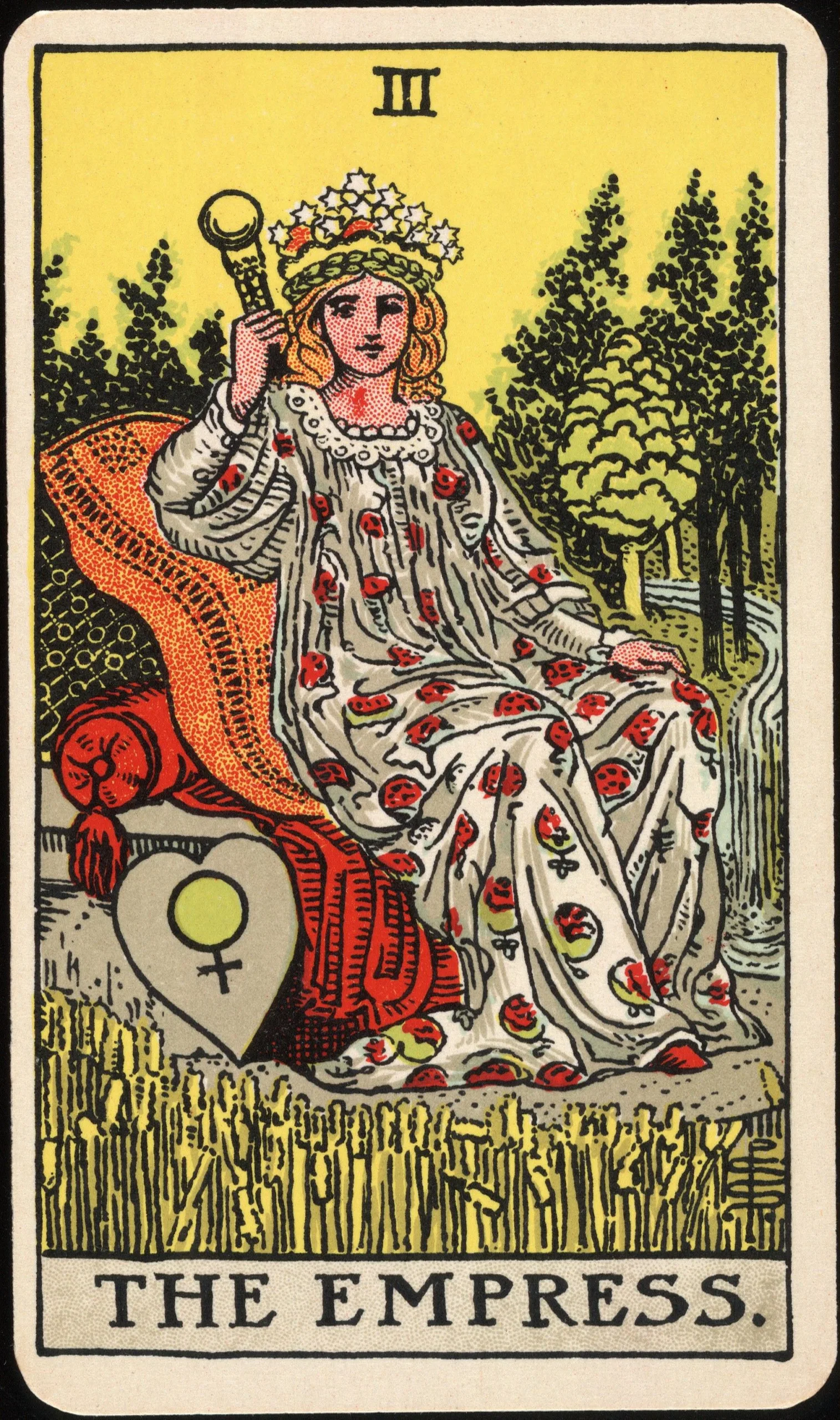
The Empress invites us to connect with our own creative potential and to nurture our projects, relationships, and dreams with love and dedication.
She encourages us to appreciate the beauty and abundance that life offers, reminding us of the importance of compassion, care, and the nurturing of ourselves and others as we journey through our lives.
III - The Empress
The Empress, resplendent in her connection to nature and the embodiment of fertility, creativity, and nurturing, radiates the essence of motherhood and the earth’s abundance.
Seated in a lush garden, often with a shield that bears the symbol of Venus, she represents the generative power of nature and the creative impulses that bring forth life. Her realm is one of growth, sensuality, and material well-being, reminding us of the bounty that surrounds us and our capacity to create and sustain life in its myriad forms.
The golden wheat at her feet, in particular, symbolizes the fruition of projects and the harvest that comes from hard work.
As the third card of the Major Arcana, the Empress embodies the synthesis of wisdom found in the preceding cards, The Magician and The High Priestess, blending their energies to create something new and life-affirming. Her number, 3, is one the expression of creativity in tangible forms. It reflects the Empress’s message that through embracing our creative powers and nurturing our ideas, we can bring forth abundance in our lives.
Her connection to Venus, the planet of love, beauty, and pleasure, further emphasizes the enjoyment of the physical world and its pleasures. The Empress is mirrored in figures of earth goddesses and maternal archetypes, such as Gaia, Demeter, and Freya, who oversee fertility, harvest, and the cycles of growth and renewal.
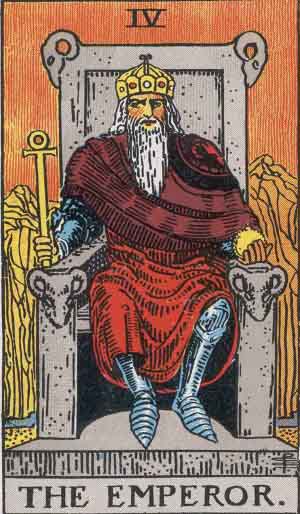
The Emperor calls us to consider the structures we are building in our own lives, encouraging us to take charge, establish order, and lead with integrity.
He shows us of the power of a strong foundation and the need for discipline and strategy in achieving our goals. Through the Emperor, we learn the value of leadership and the responsibility that comes with wielding power, guiding us toward creating a stable and secure environment for ourselves and those we care for.
IV - The Emperor
The Emperor, seated upon his throne, embodies authority and structure. Clad in armor beneath his royal robes, he represents the power of governance and the responsibility that comes with leadership.
His throne, often adorned with rams’ heads, symbolizes the drive to conquer challenges through discipline. In his hand, the scepter and orb represent the dominion over the material realm.
The number four is associated with foundation, solidity, and material reality. His presence in a reading reminds us of the importance of discipline, logic, and the application of force with wisdom to build enduring structures in our lives.
Astrologically, the Emperor is linked to Aries, a fire sign known for its leadership qualities, pioneering spirit, and courage.
The Emperor archetype is seen in mythological figures such as Zeus, Odin, and Jupiter, rulers who wield power with wisdom and authority, often serving as protectors of the realm and upholders of divine and earthly law.
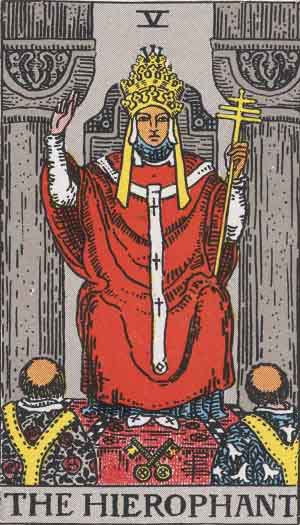
The Hierophant invites us to explore our own beliefs and the traditions that shape our lives, urging us to find wisdom in the teachings of the past while considering their relevance to our personal spiritual journeys.
He reminds us of the value of communal beliefs and the shared human quest for meaning, encouraging us to seek guidance from those who have walked the path before us and to honor the wisdom found within our collective heritage.
V - The Hierophant
The Hierophant, seated between two pillars of a sacred temple that symbolize Law and Freedom. The Hierophant represents tradition, spiritual wisdom, and the conveyance of esoteric knowledge. Clad in the vestments of a spiritual leader, he holds a triple scepter, symbolizing dominion over the three worlds—conscious, unconscious, and superconscious.
The crossed keys at his feet represent the keys to Heaven or the unlocking of esoteric knowledge. The Hierophant’s role is that of a bridge between the divine and the mundane, guiding seekers on their spiritual journeys and interpreting sacred teachings.
As the fifth card of the Major Arcana, the Hierophant embodies the principle of teaching and learning, adherence to tradition, and the importance of societal structures and beliefs. The number five is symbolic of humanity, challenge, and the need for change within stability.
The Hierophant is also associated with earth, often linked to Taurus, a sign that values tradition and stability.
The Hierophant figure can be seen in the wise teachers, priests, and gurus who have guided communities through the ages. Figures such as Confucius, Moses, and the Dalai Lama embody the Hierophant’s qualities of spiritual authority, guidance, and the dissemination of teachings.

Inviting introspection, the Lovers card encourages us to consider our values, relationships, and the choices we face, urging us toward clarity, integrity, and the pursuit of harmony in our connections with others.
It reminds us that every choice we make not only shapes our personal journey but also reflects the inner unity and balance we seek to achieve.
VI - The Lovers
The Lovers card, adorned with the imagery of two figures and an angelic presence above, symbolizes the concept of choice, the complexity of relationships, and the merging of opposites into a harmonious whole.
This card, often set in a garden reminiscent of Eden, suggests not only romantic partnership but also the moral choices we face in our journey. The angel, usually identified as Raphael, represents healing and protection, overseeing the union with divine blessing. The tree of knowledge and the serpent in the background hint at the pivotal choices that define our lives and the potential for both harmony and discord based on those decisions.
Numerologically, the Lovers is card number 6, a number that resonates with harmony, balance, and the nurturing of relationships. It reflects the card’s emphasis on choices that lead to the reconciliation of dualities within ourselves and our lives.
The card is often associated with Gemini, the sign of duality and communication.
The Lovers card echoes through various mythological tales that explore themes of love and the moral quandaries faced by humanity. From Adam and Eve to Paris and Helen, these stories reflect the complexities of desire and the quest for understanding.

The Chariot encourages us to take the reins of our lives, to direct our will with clarity and purpose, and to overcome the contradictions within ourselves.
It serves as a reminder that true progress requires a balance of strength, control, and emotional insight, driving us toward victory in our personal battles and the achievement of our deepest goals.
VII - The Chariot
The Chariot, depicted as a formidable figure steering a chariot pulled by two sphinxes of opposing colors, symbolizes determination and the triumph over obstacles through willpower.
The charioteer, clad in armor, represents the will’s armor against the distractions and conflicts of the external world, indicating focus and determination. The two creatures pulling the chariot in opposite directions symbolize the opposing forces within us that must be harnessed and directed to move forward with purpose. The city in the background signifies the ultimate goal, emphasizing the importance of a clear objective in achieving success.
Astrologically, The Chariot is linked to the zodiac sign Cancer, which brings to the forefront themes of tenacity, the protective nature of the charioteer, and the emotional drive behind the pursuit of goals.
The Chariot echoes the heroic journey where heroes embark on significant quests, overcoming daunting obstacles through strength of will and the mastery of their own nature. Figures such as Hercules and Arjuna (In the Bhagavad Gita as Arjuna was literally on a chariot during his spiritual expositions with Krishna) perfectly embody the qualities of The Chariot.
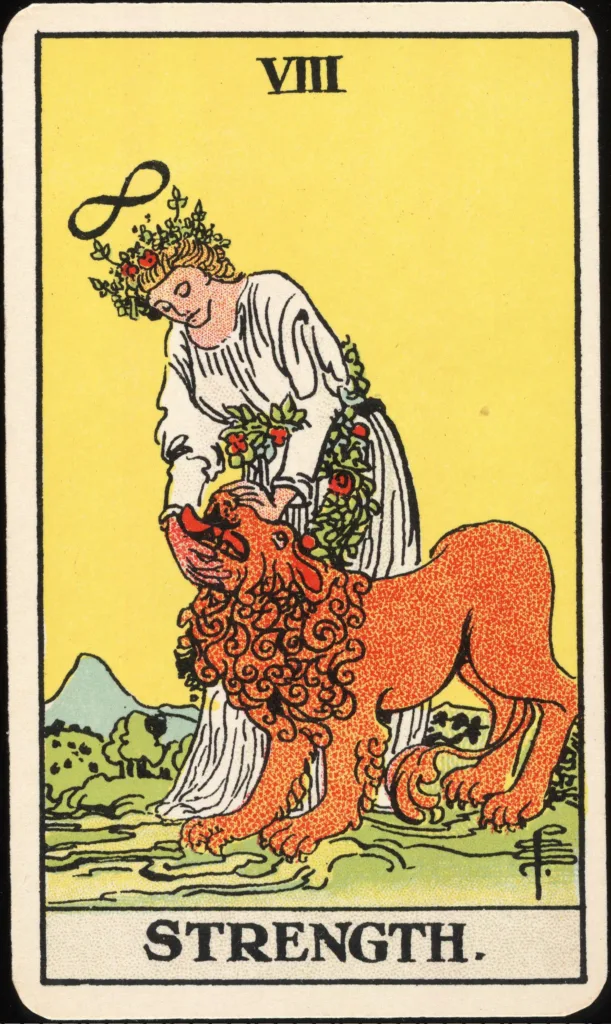
The Strength card encourages us to embrace our challenges with courage, reminding us that true power arises from the heart.
It calls us to cultivate patience, resilience, and a compassionate understanding of ourselves and others, teaching us that our greatest victories are won through the strength of our character and the gentleness of our spirit.
VIII - Strength
Strength, often depicted as a serene figure calmly closing the jaws of a lion, symbolizes not just physical strength but the power of courage, patience, and compassion.
This card illustrates the triumph of the human spirit over brute force, emphasizing inner strength and the ability to navigate challenges with grace. The figure, usually a woman, represents the force of gentle but undeniable power, showing that true strength lies in understanding and taming one’s primal instincts.
The lion, a symbol of our animal passions and fears, is tamed through kindness and inner resolve, suggesting that courage and compassion are the most potent forces we possess.
Strength represents the resolve required to face one’s challenges and the endurance needed to overcome them. The number eight, with its shape of the infinity symbol (notice the woman’s head as well), signifies balance and the cyclical nature of life’s trials and triumphs.
It’s no surprise that Strength is connected to Leo, another fire sign ruled by the sun and characterized by its boldness, warmth, and a strong sense of self.
The symbolism of Strength resonates with tales of heroes who conquer beasts not through force but through understanding. Figures such as Androcles, who removes a thorn from a lion’s paw, embody the essence of Strength.

The Hermit invites us to embrace the value of solitude, introspection, and self-reflection, encouraging us to seek the wisdom that lies within.
It reminds us that, in the noise and haste of our lives, there is profound strength and insight to be found in silence and solitude, guiding us toward our inner light and the path to true enlightenment.
IX - The Hermit
The Hermit stands atop a mountain, lantern in hand, symbolizing introspection, guidance, and the solitary pursuit of deeper wisdom.
Cloaked in the garb of a monk, this figure embodies the journey inward, away from the distractions of the external world, to seek answers within the self.
The mountain represents the heights of spiritual achievement and the challenges faced on the path to enlightenment. The lantern, illuminated by a star within, signifies the light of personal insight that guides the way through darkness.
The Hermit signifies the completion of a cycle in the seeker’s journey, marking a point of reflection, assessment, and the wisdom gained through experience. The number nine is associated with introspection, wisdom, and the culmination of lessons learned along the spiritual path.
The Hermit is also linked to Virgo, a sign characterized by a meticulous pursuit of perfection.
Figures such as Laotzu, Buddha, and Elijah represent the essence of The Hermit, embodying the journey of enlightenment that is undertaken in solitude but serves the broader purpose of guiding others with the light of wisdom gained.

The Wheel of Fortune stands as a reminder of life’s impermanence and the constant flux that defines the human experience. It calls us to embrace change with grace, to recognize the cyclical nature of our realities, and to trust in the turn of the wheel.
This card invites us to see beyond the immediate, to understand the deeper cycles at play, and to find our place within the larger cosmic order, reminding us that every ending heralds a new beginning, and with each turn of the wheel, we are offered a chance to evolve, to learn, and to thrive.
X - The Wheel of Fortune
The Wheel of Fortune depicts a grand cosmic wheel, underscoring the interconnectedness of fate and the ever-present cycles of change. At the wheel’s center is the eternal dance of progression and regression, symbolized by figures from various mythologies, each playing a role in illustrating the wheel’s significance.
The Wheel of Fortune is typically depicted with four figures in the corners of the card. These corner figures are commonly represented as four winged creatures sitting upon clouds, each reading a book. They symbolize the four Evangelists of the Christian tradition, correlating to the four fixed signs of the zodiac: the Angel (Matthew) representing Aquarius, the Eagle (John) symbolizing Scorpio, the Lion (Mark) for Leo, and the Bull (Luke) representing Taurus. These figures emphasize the universality of the card’s message, indicating that the cycles of change and fortune affect all aspects of creation and are part of a larger cosmic order.
Centered on the wheel are typically three figures: the Sphinx, Anubis, and a snake. The Sphinx, positioned at the top, symbolizes knowledge, stability, and the balance that comes with understanding the nature of the wheel. Anubis, ascending on one side, represents protection, transition, and the upward movement of good fortune or elevation in understanding. The snake, often descending on the opposite side, symbolizes the downward spiral, the challenges, or the aspects of life that pull one away from higher understanding and fortune.
Central to the Wheel of Fortune is the concept of karma, the idea that our actions and intentions ripple through time, influencing our future. The wheel itself, inscribed with letters T-A-R-O (or R-O-T-A, Latin for “wheel”), and with the alchemical symbols for mercury, sulfur, water, and salt, represents the alchemical transformation that life’s cycles initiate.
Astrologically, the Wheel of Fortune is linked to Jupiter, the planet of luck, expansion, and abundance.

Justice invites us to reflect on our sense of fairness, to consider our actions and their impacts on our lives and the lives of others.
It challenges us to strive for balance in our personal and external worlds, encouraging us to act with integrity and to uphold the principles of truth and equity.
By embracing the qualities of Justice, we are reminded of the importance of accountability, the value of impartiality, and the transformative power of living in alignment with our deepest truths.
XI - Justice
Justice, depicted as a figure seated between two pillars, similar to the High Priestess but embodying the law, symbolizes the search for truth, the need for equilibrium, and the consequences of our actions.
Clad in a red robe with a crown of authority on her head, Justice holds a sword in one hand, representing decisive thought and action, and scales in the other, illustrating the weighing of evidence and balance.
Justice conveys the idea of karmic retribution and the importance of making choices grounded in integrity. The number 11 speaks to mastery, moral responsibility, and the need to align with one’s inner truth, highlighting the dual nature of Justice’s sword—cutting through deceit to reveal truth, while also delivering the consequences of our choices.
It’s no surprise that Justice is associated with Libra, the sign of the scales.
The figure of Justice embodies the principle of cause and effect, reminding us that our actions have consequences and that we must account for our decisions. In many cultural traditions, Justice is personified by figures who uphold the law and moral order, such as Themis or Maat, deities who represent the inherent order of the universe.

This card often calls for a reevaluation of our life’s path, encouraging us to release outdated modes of thinking or being that no longer serve us. It suggests that through the act of suspension—pausing our lives or our projects and looking at them from a new angle—we can discover alternative solutions and deeper truths about our existence.
By embracing this period of suspension and looking at the world from a new perspective, we can prepare ourselves for the changes that lie ahead, developing a deeper understanding of our place in the universe and the wisdom that comes from letting go.
XII - The Hanged Man
The Hanged Man, a symbol deeply rich in paradox. This card typically depicts a man suspended upside down by one foot, usually from a tree, with his other leg crossed behind his knee, forming a cross, and his hands bound behind his back. This pose suggests voluntary sacrifice and the suspension of one’s usual way of seeing the world.
The Hanged Man’s inverted state represents seeing things from an entirely new perspective, embracing uncertainty, and letting go of preconceived notions.
It’s a card of significant spiritual contemplation, indicating a period of pause and reflection that precedes a major transformation. The serene expression on the Hanged Man’s face implies peace and acceptance of his situation, highlighting the theme of surrender as a path to wisdom.
The Hanged Man is astrologically associated with Neptune, the planet of dreams, illusions, and higher spiritual connections.
The Hanged Man’s number, 12, combines the one (symbolizing beginning, focus, individuality) and the two (representing duality, flexibility, and balance) to reflect a state of in-between. The number 12 also relates to cycles, such as the 12 zodiac signs or the 12 months, suggesting a completion of one cycle and the impending start of another.
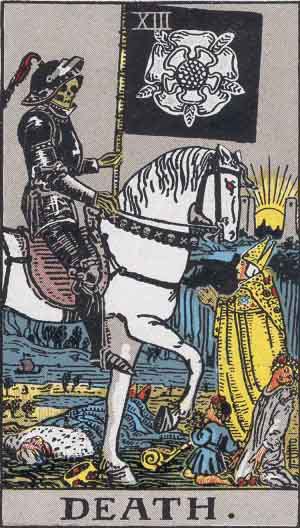
This card does not necessarily predict physical death but rather signifies a metaphorical symbolic death — the death of a phase, belief, relationship, or way of life that no longer serves one’s journey. It calls for an embrace of change, however difficult, as a necessary step toward evolution.
The Death card invites acceptance, urging us to let go of the past to make room for new opportunities and beginnings. It is a reminder that transformation, while often challenging, is a powerful force for personal growth and renewal, encouraging us to shed what we no longer need to welcome the new paths that await us.
XIII - Death
Death.
A card that, despite its ominous name, carries profound meanings of transformation, endings, and the natural cycle of rebirth. This card typically features a skeletal figure, often riding a pale horse akin to the same character in the Four Horsemen of the Apocalypse. Standing amongst a crowd of figures from all walks of life, signifying that death comes to everyone regardless of status. This skeletal figure is sometimes depicted carrying a flag, symbols of the finality and equality of death, but also of the harvest — a gathering of what has been sown, suggesting a necessary clearing to make way for new growth.
The Death card encourages us to confront our fears about endings and to recognize that with every conclusion comes the promise of a new beginning. It reminds us that transformation is a natural and essential part of life.
The imagery of the card, often including a rising sun in the background, emphasizes this cycle of death and rebirth, indicating that while one phase ends, another begins.
Astrologically, Death is associated with Scorpio, a sign known for its connection to transformation, the mysteries of life and death, and the depths of the human psyche.
As card number 13, Death symbolizes the breaking down of old structures to make way for the new. The number 13, often regarded with superstition, aligns with the Death card’s themes of transition and the unearthing of deeper, sometimes unsettling truths that ultimately lead to growth.
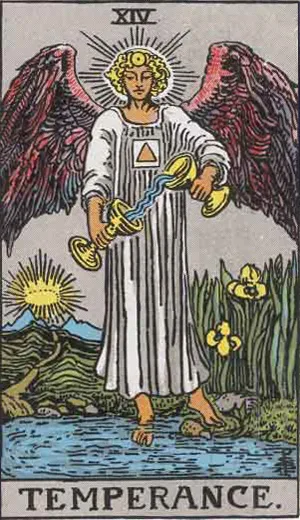
Temperance calls for patience, self-control, and the thoughtful blending of diverse elements of one’s life to achieve a state of inner peace and purposeful direction.
It serves as a reminder that true strength lies in the ability to harmonize, to adapt fluidly to life’s complexities, and to walk the middle path with wisdom and grace.
XIV - Temperance
Temperance symbolizes moderation and the middle path.
Depicted as an angelic figure standing with one foot on land and the other in water, Temperance illustrates the blending of opposites and the harmonious flow between the material and spiritual worlds.
The angel is often shown pouring liquid between two cups, signifying the alchemical process of integration, the perfect mixing of diverse elements to create something new.
The backdrop of the Temperance card, typically a path leading to a distant mountain and the horizon, suggests a journey toward a higher purpose or understanding, indicating that balance is not an end state but a dynamic process of adjustment and alignment on one’s path. The angel is sometimes identified as Michael, the protector and the mediator.
Temperance is also associated with Sagittarius, the sign of exploration, philosophy, and the search for truth.
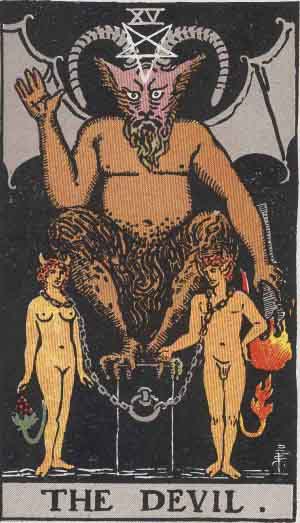
The Devil card invites a deep examination of our attachments, fears, and the shadow self. It challenges us to confront these aspects with courage, encouraging us to reclaim our power by acknowledging that our limitations are often self-imposed.
By facing our shadows and understanding the nature of our bondage, we open the door to liberation, reminding us that true freedom comes from within and that the light of consciousness can dispel the darkness of ignorance.
XV - The Devil
The Devil card, often misunderstood, symbolizes bondage, materialism, and the shadow side of human nature.
This card features a figure resembling Baphomet, a creature that is half-man, half-goat, embodying the concept of duality — blending human intelligence with animalistic desire. The Devil sits upon a dark throne, dominating over two figures, usually a man and a woman, chained to his pedestal. These chains, however, are loose, indicating that the bondage is more psychological than physical, suggesting that the perceived limitations and addictions are self-imposed.
The woman’s tail, ending in grapes, represents indulgence and the seduction of pleasure, while the man’s tail, ending in flames, signifies destruction and unchecked passion. These tails emphasize the consequences of surrendering to base instincts without the balance of higher awareness.
Above The Devil’s head, an inverted pentagram shines prominently. Traditionally a symbol of spirituality (with the single point upward representing spirit over the four elements), its inversion here underscores the theme of materialism dominating spirit, highlighting the inversion of values and the perversion of natural laws under The Devil’s influence.
The torch that The Devil holds not only illuminates the darkness but also symbolizes the light of awareness that can free us from our self-imposed shackles.
The Devil is thus associated with Capricorn, a sign known for its discipline, ambition, and the drive for success. This connection highlights the card’s themes of ambition gone awry, where the pursuit of material achievements or the need for control can lead to a sense of entrapment and the neglect of one’s spiritual well-being.
The number 15, breaking down to 1+5=6, connects back to The Lovers card which is why we find them once again here, underscoring the importance of conscious decision-making in escaping The Devil’s illusionary grip.
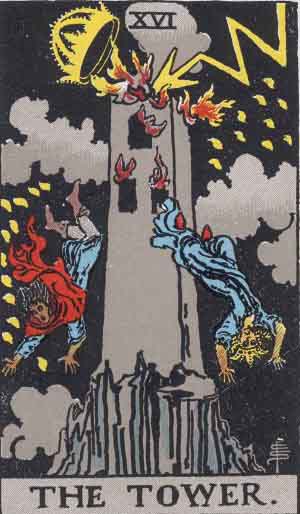
The Tower card challenges us to embrace the unpredictable nature of change and to recognize the potential for growth in what may initially appear as disaster.
It reminds us that the most profound transformations often come from the collapse of our most rigid structures, urging us to rebuild on more authentic foundations.
XVI - The Tower
The Tower dramatically captures a moment of unexpected upheaval and the dismantling of existing structures. It depicts a tower being struck by lightning, leading to its destruction, while two figures plummet from its heights.
The lightning bolt that strikes the tower is a symbol of sudden revelation or divine intervention that forcefully removes outdated beliefs. This act of destruction is not without purpose; it clears the way for new growth and understanding, even if the process is tumultuous, similar to the story of the Tower of Babel.
The tower itself, built on shaky foundations, represents aspects of life that are not as stable as they seem. Its fall signifies the collapse of false premises and the illusions upon which we often build our lives.
The figures falling from the tower symbolize the fear that accompany significant life changes. However, their descent also suggests liberation from previously confining situations.
Astrologically, The Tower is associated with Mars, the planet of war, action, and aggression. This connection underscores the card’s themes of conflict, destruction, and the forceful removal of obstacles.
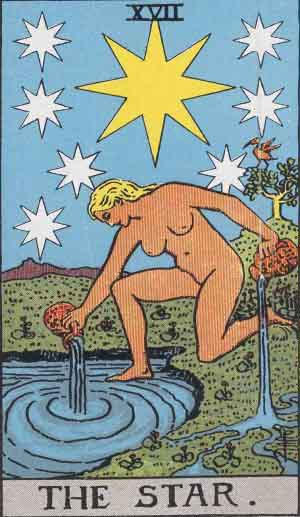
The Star shines as a beacon of hope, encouraging healing, reflection, and the pursuit of a higher understanding.
It assures us that after the storm, there is always a return to calmness, where inner and outer harmony can be restored, guiding us towards a deeper connection with the cosmic rhythm and the unfolding of our spiritual journey.
XVII - The Star
The Star card offers a message of hope, renewal, and spiritual clarity.
In its imagery, a tranquil figure, often depicted as a woman, kneels at the water’s edge, pouring water from two vessels. This act symbolizes the healing and replenishment that flows when we connect with our inner selves and the universe. Above her, a large, luminous star, accompanied by seven smaller stars.
The presence of the large star suggests the essence of our true spirit, while the surrounding seven smaller stars represent the Seven Chakras or the classical planets, emphasizing the alignment of personal energy with cosmic forces. The five lines from the water on land represents the five senses.
Similarly, The Star is associated with Aquarius, a sign symbolizing innovation, community, and idealism. Aquarius’s influence also speaks to the individual’s role in contributing to a larger vision or collective dream.
When viewed through the lens of Pandora’s myth, where hope remains as a solace amidst chaos, or the guiding stars in countless traditions, The Star reminds us of the light that follows darkness, offering guidance, healing, and the promise of a brighter future.
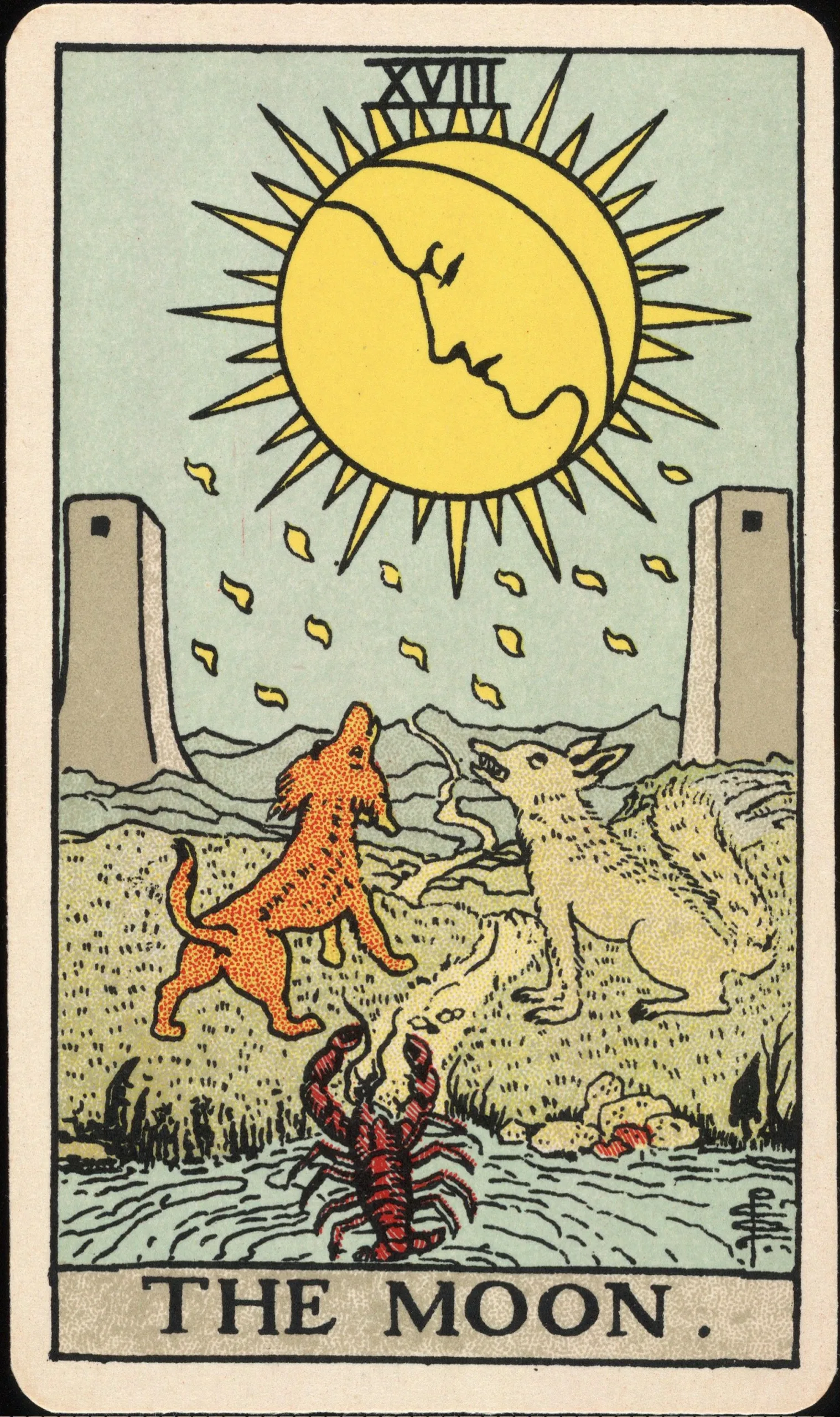
The Moon serves as a powerful reminder of the need to heed our inner voice, to confront our fears and anxieties, and to embrace the journey into the depths of our being.
It encourages a pilgrimage into the unknown, guided by the light of intuition and the acceptance of the complex landscape of the human psyche.
XVIII - The Moon
The Moon card depicts a night scene with a full moon hanging in the sky, casting a soft light over a landscape that often includes a path leading into the distance, flanked by two towers. A dog and a wolf howl at the moon, while a crayfish emerges from the water.
The Moon itself symbolizes the realm of the subconscious, dreams, and the intuition that lies beneath the surface of conscious awareness. The dog and the wolf represent the tamed and wild aspects of our nature, both howling at the moon, suggesting the thin veil between the domesticated self and the primal urges.
The Moon has sixteen chief rays and sixteen secondary rays. The primary rays can be seen as manifestations of the conscious mind, while the secondary rays represent the subconscious elements.
Furthermore, there are Yodh shape dews being scattered. In the Hebrew alphabet, Yodh is the smallest letter, often associated with the divine spark or the starting point of all potential in the Kabbalistic tradition.
The crayfish emerging from the water signifies the awakening of the subconscious mind and the emergence of previously repressed aspect of the self. It symbolizes the beginning of a journey into the unconscious, inviting introspection and the exploration of deep, internal landscapes.
The Two Towers on either side of the path represent the constructs that we navigate between — they mark the passage into the unknown and the Path leading between the towers and into the distance symbolizes the journey of life.
Astrologically, The Moon is associated with the sign of Pisces, which enhances the card’s themes of intuition, mystery, and the fluid boundaries of the emotional and psychic realms.
The Moon card can be connected to lunar deities from Artemis, Chang’e, and Hecate, lunar goddesses represent the power of the night, the mysteries of the unseen, and the intuitive understanding that comes from embracing the darkness.

The Sun celebrates the abundance of life and the joy that comes from achievement and self-realization.
It encourages embracing the light within and around us, fostering an environment where our true selves can thrive and our dreams can become reality.
This card shows us the boundless positivity and potential that life holds, inviting us to bask in the warmth of success, clarity, and personal power.
XIX - The Sun
The Sun radiates joy, vitality, and success. This card depicts a large, bright sun shining in the sky, with sunflowers in the background and a child joyfully riding a white horse.
The Sun itself is a universal symbol of life force, energy, and clarity. It illuminates the darkest corners, bringing warmth, growth, and vitality to all it touches. Its presence in the card represents success, achievement, and the realization of personal goals, signifying a period of great positivity and vibrant energy.
The child riding a white horse symbolize innocence and the joy of being. It reminds us of the importance of connecting with our inner child, embracing simplicity, and finding bliss in the present moment. Their nakedness highlights vulnerability but also the freedom that come from being true to oneself.
Sunflowers represent the human soul’s quest for truth, always seeking the light of understanding and spiritual fulfillment.
The white horse carries the child effortlessly. This represents the ease with which joy and success can be attained when one aligns with one’s true purpose and embraces life with a sense of wonder.
Of course, The Sun is associated with the Sun itself, embodying vitality, ego, and the conscious mind. This celestial body’s influence on the card speaks to the core identity, creativity, and the life force that drives personal expression and the will to succeed.
The Sun card draws on the universal reverence for the sun as a giver of life and a guide through darkness. Across civilizations, the sun has been worshipped as a deity representing power, growth, and enlightenment, from the Slavic god Dazhbog, Egyptian sun god Ra to the Greek god Helios.

Judgement invites introspection, urging us to heed the inner call to higher consciousness. It signifies a time of significant personal transformation, where the past is reviewed and released, making way for a new chapter characterized by greater authenticity, purpose, and spiritual alignment.
It challenges us to rise, embrace our full potential, and step forward into a life that reflects our truest selves and highest aspirations, guided by the divine light of awareness.
XX - Judgement
The Judgement card encapsulates themes of rebirth and awakening drawing deeply from Christian imagery of the Resurrection and the Last Judgment.
At the heart of this card is an angel, Metatron, blowing a great trumpet adorned with the flag of St. George, a symbol found in the 15th chapter of 1 Corinthians, representing the divine call to awakening and the triumph over death.
This sound of the trumpet acts as a universal summons, echoing through the consciousness of all who hear it, heralding a time for self-evaluation, absolution, and the profound opportunity for redemption.
Beneath the angel, a group of resurrected individuals—a man, woman, and child—stand with arms spread wide, their expressions one of awe. Their emergence from crypts, depicted with sallow complexions, signifies the soul’s response to the celestial call, ready to transcend past limitations and embrace a renewed existence. This moment of resurrection draws inspiration from the Book of Revelation, evoking the sea giving up its dead.
The scene is set against a backdrop of snow-covered mountains, reminiscent of The Hermit’s solitude, symbolizing a period of stillness and the purity required for the soul’s renewal. These mountains speak to the cyclic nature of life’s endings and beginnings, the essential quiet before the rebirth.
Astrologically linked to Pluto, the planet of rebirth and transformation, Judgement’s imagery and symbolism are imbued with the energies of profound change, regeneration, and the shedding of old identities.
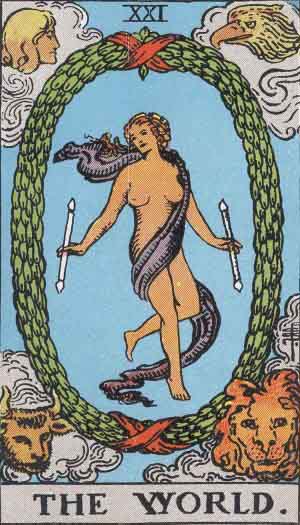
The World card presents a message of wholeness and unity with the cosmos.
It invites reflection on the journey that has been undertaken, encouraging gratitude for the lessons learned and the achievements gained.
It serves as a reminder of the interconnectedness of all things and the continuous cycle of growth and renewal.
As the final card of the Major Arcana, The World signifies not just an end but also the promise of new beginnings, offering a moment to pause, reflect, and celebrate before embarking on the next phase of life’s eternal journey.
XXI - The World
The World, the 21st and final card of the cycle, encapsulating completion and unity.
The androgynous figure represents the synthesis of male and female energies (the yin and yang), underscoring the importance of internal balance and the unification of diverse aspects of the self. This unity leads to a state of completeness, transcending binary notions of gender to encompass a more holistic understanding of the self and the universe.
The figure is surrounded by a green wreath, often tied with red ribbons in the shape of a lemniscate (infinity symbol), and is flanked by four living creatures of Jewish mythology—the man, the lion, the ox, and the eagle—paralleling the Christian tetramorph of the four Evangelists and representing the four fixed signs of the zodiac: Aquarius (man), Leo (lion), Taurus (ox), and Scorpio (eagle). These figures symbolize the harmony of all elements (Astrologically the four are: air, fire, earth, and water signs) and the balanced integration of the natural world.
The wreath, a circle that represents completion and eternity, suggests the accomplishment of one’s goals and the realization of unity within the self and with the universe. The red ribbons, forming the lemniscate (infinity symbol), emphasize the infinite nature of the soul’s journey and the ongoing process of growth and discovery.
Astrologically, The World is associated with Saturn, the planet of karma. Saturn’s influence is reflected in the achievement of goals through perseverance, as well as in the realization of the lessons learned throughout the journey of the Major Arcana, otherwise known as The Fool’s Journey.


